#pinxter
Explore tagged Tumblr posts
Text
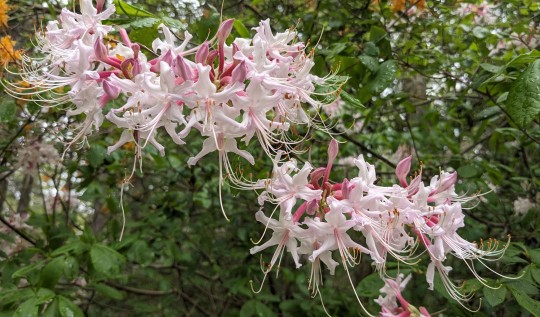
Rhododendron periclymenoides / Pinxter Flower at the Sarah P. Duke Gardens at Duke University in Durham, NC
#Rhododendron periclymenoides#Rhododendron#Ericaceae#Pinxter Flower#Pink Azalea#Azalea#Azaleas#Native plants#Native flowers#Native shrubs#Plants#Flowers#Shrubs#Nature photography#photographers on tumblr#Sarah P. Duke Gardens#Duke Gardens#Duke University#Durham#Durham NC#North Carolina
3 notes
·
View notes
Text








Little summer river hike, taking lots of photos
#hike#hiking#plant#plants#iris#yellow iris#fern#skunk cabbage#rhododendron#deer tongue#pinxter flower#plant identification#plant id#nature
1 note
·
View note
Text

13 Night of South Park Halloween
Night 5
It's 13 Nights of South Park Halloween and in this night, it's Jinxter and Pinxter as animatronics.
(Note: This is for 10 years of Five Nights at Freddy's.)
Made with Microsoft Paint, Photopea and GIMP.
South Park (c) Trey Parker, Matt Stone, South Park Studios, MTV Entertainment Studios and Comedy Central
Five Nights at Freddy's (c) Scott Cawthon and Steel Wool Studios
Idea and artwork (c) me
#13 days of halloween#halloween#south park#south park ocs#original characters#five nights at freddy's#fnaf#animatronics
4 notes
·
View notes
Text
How to Grow & Care for Rhododendron Periclymenoides?

Did you know that the Pinxterbloom Azalea is a stunning native flowering shrub in eastern North America? With its late spring bloom time and fragrant pink flowers, this deciduous shrub is a favorite among gardeners and nature enthusiasts. Not only does it add beauty to gardens and landscapes, but it also attracts many plants such as bees and butterflies. Pinxter Azalea (Rhododendron periclymenoides ) is a must-have deciduous shrub for any garden collection. Its delicate azaleas provide a burst of color and fragrance from their fragrant flowers that can't be missed. While there are various hybrids available, the pure beauty of this native species remains unmatched. When caring for your Pinxterbloom Azalea plants, keep an eye out for leaf spot disease, which can affect the health of these shrubs. To ensure proper care, refer to label directions and consult a glossary of terms if needed. With their captivating appearance and ecological benefits, these azalea plants are sure to captivate both seasoned gardeners and beginners alike. So why not bring some natural beauty into your backyard with the enchanting Pinxterbloom Azalea shrubs available at your local garden center? These stunning plants will add a pop of color to your garden.
Planting and Growing Rhododendron periclymenoides

To successfully grow and care for rhododendron periclenoides and other azaleas, there are a few important factors to consider. Follow these guidelines to ensure the optimal growth of these beautiful flowering shrubs. Visit your local garden center for the best selection of plants. - Choose a location with partial shade: Rhododendron periclymenoides thrives in partial shade, so select a spot in your garden that receives sunlight for only part of the day. This will provide the right balance for its growth. - Prepare the soil properly: Before planting, prepare the soil by adding organic matter like compost. This will improve drainage and enrich the soil with nutrients necessary for healthy growth. - Dig a hole twice as wide as the root ball: When planting your rhododendron periclymenoides, dig a hole that is twice as wide as the root ball. This will give its roots enough space to spread out and establish themselves. - Water regularly, especially during dry periods: Rhododendrons require consistent moisture, particularly during dry periods. Regular watering will help prevent wilting and promote healthy vegetative growth. - Be cautious about overwatering: While it's important to water regularly, avoid overwatering as it can lead to root rot and fungal growth. Ensure proper drainage in your planting area to prevent waterlogged conditions. By following these simple steps, you can create an ideal environment for your azaleas to thrive. Remember to choose a suitable location with partial shade for your plants, prepare the soil properly, dig an appropriate hole when planting their leaves, and water regularly in the spring while avoiding overwatering. To support the growth of your rhododendron periclymenoides during the spring season, you may also consider applying a suitable fertilizer specifically formulated for acid-loving plants. This will provide additional nutrients to promote healthy new growth and vibrant blooms, as the water and light from the sun are plentiful during this time.
Caring for Rhododendron periclymenoides
Aspect Care for Rhododendron periclymenoides Sun exposure Partial shade to full shade Soil Well-draining, acidic soil Watering Regular watering, keeping the soil moist Fertilization Fertilize in spring with acid-loving fertilizer Pruning Prune after flowering to shape and remove dead wood Mulching Apply a layer of mulch to retain moisture and suppress weeds Disease control Monitor for diseases such as powdery mildew and treat them promptly Pest control Watch for pests like aphids and treat as needed Winter care Protect from harsh winter winds and frost with burlap or other coverings Mulch around the base of the plants to conserve water and suppress weeds. This helps create a favorable environment for your rhododendron periclymenoides to thrive in the sun. Use organic mulch such as wood chips or pine needles, spreading it in a layer about 2-3 inches thick. Cut back your plants after they have finished flowering to maintain their shape and remove any dead or damaged branches. This will not only improve the appearance of your plants but also encourage healthy growth. Use clean pruning shears to trim back any overgrown branches or those that are crossing each other. Ensure your plants receive plenty of light and sun for optimal growth. Fertilize in early spring with a slow-release, acid-loving plant fertilizer to provide the necessary nutrients for rhododendrons. These plants prefer acidic soil, so it's important to choose a fertilizer specifically formulated for acid-loving plants. Follow the instructions on the packaging for proper application rates to ensure that your rhododendrons receive the right amount of water, sun, and light. Monitor your plants for pests such as aphids or lace bugs and take appropriate action if necessary. These pests can cause damage to your rhododendron periclymenoides if left unchecked. If you notice signs of infestation, consider using organic insecticides or natural pest control methods recommended for rhododendrons. Additionally, ensure that you cut your plants regularly, provide them with enough water, and place them in a spot where they can get ample sun. By following these care tips, you can ensure that your rhododendron periclymenoides plants remain healthy and vibrant throughout their growing season. Make sure to water your plants regularly and provide them with enough sun. Additionally, remember to cut off any dead or damaged parts of the plants to promote their overall health.
Understanding the Needs of Rhododendron periclymenoides

Rhododendron periclymenoides, commonly known as pinxterbloom azalea, is a beautiful flowering shrub that requires specific care to thrive in the sun and water. To ensure the health and vitality of this plant, it is essential to understand its need for sunlight and regular watering. - Well-Draining Soil: Rhododendron periclymenoides thrive in soil that drains well while retaining moisture. It is crucial to provide it with soil that is rich in organic matter, allowing for proper root development and nutrient absorption. - Acidic Soil pH: This species of rhododendron prefers acidic soil with a pH ranging from 4.5 to 6.0. Maintaining the appropriate pH level ensures optimal growth and nutrient availability for the plant. - Regular Watering: While rhododendron periclymenoides benefit from regular watering, it is important not to overwater it. The frequency of watering may vary depending on factors such as climate and soil moisture retention capacity. A good rule of thumb is to water when the top inch of soil feels dry. - Climate Considerations: This particular rhododendron variety performs best in regions with cool summers and mild winters. It appreciates a temperate climate where it can experience a dormant period during winter months without extreme cold temperatures. By understanding the water and plants' needs, you can provide your rhododendron periclymenoides with an environment conducive to their growth and overall well-being. Remember: - Use well-draining soil rich in organic matter. - Maintain an acidic soil pH between 4.5 and 6.0. - Water regularly but avoid overwatering. - Consider planting water-loving plants in regions with cool summers and mild winters. With proper care, your rhododendron periclymenoides plants will flourish and reward you with stunning blooms. Water them regularly to ensure their growth and beauty.
Tips for Successful Rhododendron Periclymenoides Care
Tips for Successful Rhododendron Periclymenoides Care 1. Choose the right location for planting 2. Provide well-drained soil 3. Ensure proper watering 4. Mulch around the base of the plant 5. Prune after flowering 6. Protect from harsh winter conditions 7. Monitor for pests and diseases 8. Fertilize regularly Protecting your rhododendron periclymenoides from strong winds is crucial to ensure the delicate blooms remain intact. Strong winds can easily damage these beautiful flowers, so it's important to provide them with a windbreak. Consider creating a windbreak using a fence or strategically planting taller shrubs around your rhododendron to shield the plants from the strong winds and prevent water loss. When selecting a location for your rhododendron periclymenoides, avoid planting it near trees or shrubs that compete for water and nutrients. These plants can deprive your rhododendron of the essential water and nourishment it needs to thrive. Choose an area where it can receive ample sunlight and has access to well-draining soil that retains water. To promote healthy growth, make use of an ericaceous fertilizer specifically formulated for rhododendrons. These acid-loving plants require specific nutrients, including water, that are not always present in regular fertilizers. Look for a fertilizer designed specifically for rhododendrons and follow the instructions on the packaging for the best results. Regularly monitoring soil moisture levels is vital to keep your rhododendron periclymenoides, a type of plant, happy and healthy. Use your finger or a moisture meter to check the moisture content in the soil. Aim to keep the soil consistently moist but not waterlogged. Overwatering can lead to root rot, while underwatering can cause stress and hinder the growth of plants. By following these tips, you'll successfully grow and care for your rhododendron periclymenoides plants. Protect them from strong winds, choose their planting location wisely, use specialized fertilizer, and diligently monitor soil moisture levels. With proper care, you'll enjoy vibrant blooms and lush foliage from these stunning water-loving plants.
Ideal Conditions for Rhododendron Periclymenoides Growth
Ideal Conditions for Rhododendron Periclymenoides Growth Temperature Light Soil Moisture pH level Fertilizer Pruning To ensure optimal growth and care for your rhododendron periclymenoides, it is essential to create ideal conditions for plants. Here are some key factors to consider, such as providing adequate water for your plants. - Location: Choose a spot that provides dappled sunlight or morning sun with afternoon shade. This will protect the plant from scorching and help it thrive. - Soil Drainage: Ensure the soil has good drainage to prevent root rot. Rhododendrons prefer well-draining soil, so avoid waterlogged areas. - Moisture Levels: Maintain consistent moisture levels in the soil without overwatering. Rhododendrons require enough water to stay hydrated but can suffer if their roots are constantly soaked. - Winter Protection: Shield your rhododendron from extreme temperatures, especially during winter. Harsh cold can damage the plant, so consider covering it or moving it to a sheltered location when necessary. By considering factors such as hardiness zone, soil moisture, and pH levels, you can create suitable conditions for your rhododendron periclymenoides to flourish. Remember to provide the right environment for your plants by taking into account water and other essential factors. Now that you know how to create ideal conditions for your rhododendron periclymenoides, including proper watering, you're one step closer to enjoying its vibrant blooms and lush foliage.
Troubleshooting Common Issues with Rhododendron periclymenoides
Common Issues Causes Solutions Pest infestation Insects such as aphids, scale insects, and spider mites Use insecticidal soap or neem oil to control pests Fungal diseases Overwatering, poor drainage, or humid conditions Improve drainage, water in the morning, and apply fungicides Nutrient deficiencies Lack of essential nutrients such as nitrogen, phosphorus, or iron Apply appropriate fertilizers or amendments to correct deficiencies Leaf discoloration Sunburn, nutrient deficiencies, or pH imbalance Provide shade, adjust soil pH, or address nutrient deficiencies Wilting or drooping leaves Underwatering, overwatering, or root rot Adjust watering schedule, improve drainage, or treat root rot if present Poor flowering Lack of sunlight, improper pruning, or nutrient deficiencies Provide adequate sunlight, prune properly, and fertilize as needed Stunted growth Lack of sunlight, poor soil quality, or overcrowding Ensure proper sunlight, improve soil quality, and space plants adequately Winter damage Cold temperatures, frost, or windburn Provide winter protection such as mulching or covering with burlap Transplant shock Damage to roots during transplanting Minimize root disturbance, water thoroughly after transplanting, and provide shade Leaf spot Fungal or bacterial infections Remove affected leaves, improve air circulation, and apply appropriate fungicides or bactericides Yellowing leaves - Nutrient deficiencies or overwatering can cause yellowing leaves. Brown spots on leaves - Fungal diseases like leaf spots may be the culprit behind brown spots on plants' leaves due to lack of water. Wilting or drooping foliage - Underwatering or root issues can lead to wilting or drooping foliage in plants. Stunted growth or lack of blooms - Improper pruning or insufficient light can result in stunted growth or a lack of blooms in plants. Water is also crucial for their healthy development. If you notice any problems with your rhododendron periclymenoides plants, it's important to take action. Address nutrient deficiencies by fertilizing appropriately and ensuring proper watering practices for your plants. If fungal diseases are present, consider using fungicides recommended for leaf spot treatment on your plants. To prevent wilting, make sure your plants are receiving adequate water and check for any root problems that may need attention. For stunted growth or a lack of blooms, evaluate your pruning techniques and provide sufficient light exposure for your plants. Remember that crown rot is another potential issue to watch out for in rhododendron periclymenoides. This condition occurs when the base of the plant becomes infected and starts to decay. To prevent crown rot, avoid overwatering, and improve drainage around the roots by adding organic matter to the soil. Regularly inspect your plants for any signs of crown rot and promptly remove affected areas if detected. By troubleshooting common issues promptly and providing appropriate care, you can ensure your plants, such as the rhododendron periclymenoides, thrive and produce beautiful blooms year after year. This includes giving them the necessary water they need to flourish.
Enjoying the Beauty of Rhododendron periclymenoides

Congratulations on taking the first steps towards growing and caring for Rhododendron periclymenoides! With proper attention and care, you can enjoy the vibrant beauty of these stunning plants in your garden. Let's summarize what we've covered so far: watering is essential for the growth and health of your Rhododendron periclymenoides. - Planting and Growing Rhododendron Periclymenoides: We discussed the importance of choosing a suitable location for planting these plants, preparing the soil to ensure their optimal growth, and providing them with adequate sunlight and water. - Caring for Rhododendron periclymenoides: We explored essential maintenance tasks such as watering, pruning, fertilizing, and protecting against pests and diseases to ensure the health and longevity of your plants. - Understanding the Needs of Rhododendron periclymenoides: By learning about the specific requirements of these plants for soil acidity, moisture levels, and temperature tolerance, you can create an environment that fosters their growth and ensures they receive adequate water. - Tips for Successful Rhododendron Periclymenoides Care: We provided valuable tips on mulching, winter protection, regular monitoring, and watering to address potential issues before they become major problems. - Ideal Conditions for Rhododendron Periclymenoides Growth: By replicating their natural habitat conditions such as partial shade, well-drained soil, and adequate water, you can optimize the growth potential of these plants. - Troubleshooting Common Issues with Rhododendron Periclymenoides: We highlighted common problems like leaf discoloration or wilting in these plants and offered solutions to overcome water-related issues effectively. Now that you have a solid understanding of how to grow and care for rhododendron periclymenoides, it's time to put your knowledge into action! Get started by selecting healthy plants from reputable nurseries or propagating them from cuttings. Remember, patience and consistent care are key to enjoying the full beauty of these remarkable water-loving plants. FAQs How often should I water my rhododendron periclymenoides? The Rhododendron periclymenoides plant thrives in moist soil, making regular watering crucial. Read the full article
0 notes
Photo

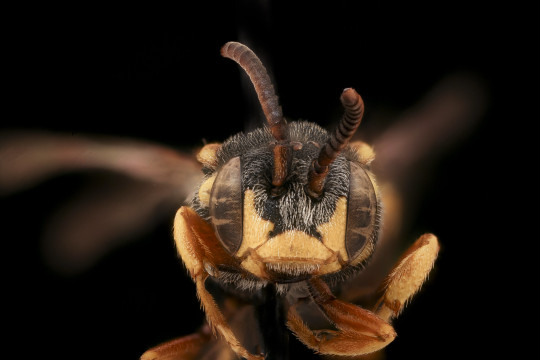

Another lovely and mysterious Nomada. Nomada placida. Eastern U.S. This one from Highland County. Late season species. Host - Unknown, Probably Andrena, but....other possibilities exist. Collected by Steve Roble in Highland County, Virginia. So many scintillating worlds out there that we walk by thinking about bears when we should be thinking about Nomada. Photo by Erick Hernandez.
#golden#striped#yellowdot#dotted#antennae#pointed#winged#flying#bing#orch#elevate#orache#sentinal#fierce#fighter#song#pinxter#faire#ask#singel#singer#singe#pigmentation#pig#usgs
123 notes
·
View notes
Photo

West Virginia Wildflowers A study in pink and yellow Pink lady slipper, pinxter flower,, Fleabane, Drumheads, #westvirginia #wildflowers #botanical #janedavenportwatercolors #watercolor #watercolorpainting #gouache #purple #art #artofinstagram https://www.instagram.com/p/CRDJvsgrCl3/?utm_medium=tumblr
#westvirginia#wildflowers#botanical#janedavenportwatercolors#watercolor#watercolorpainting#gouache#purple#art#artofinstagram
1 note
·
View note
Photo

Hello, there, buddy. #pinxter #pinkazalea #spring2018 #primavera2018 (at Cleveland, Tennessee)
0 notes
Photo
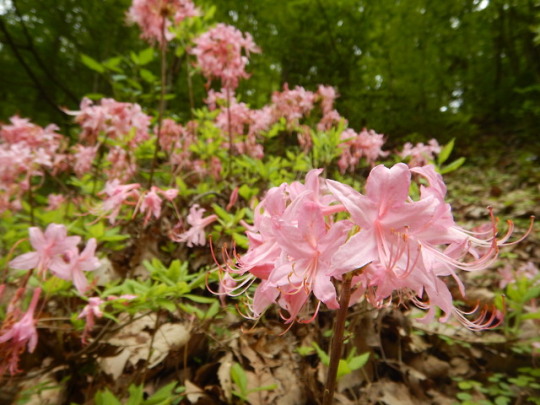
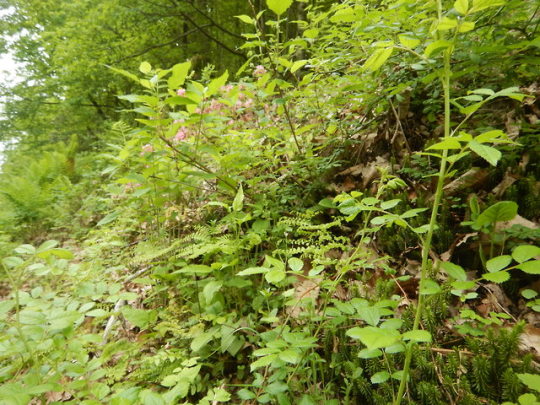
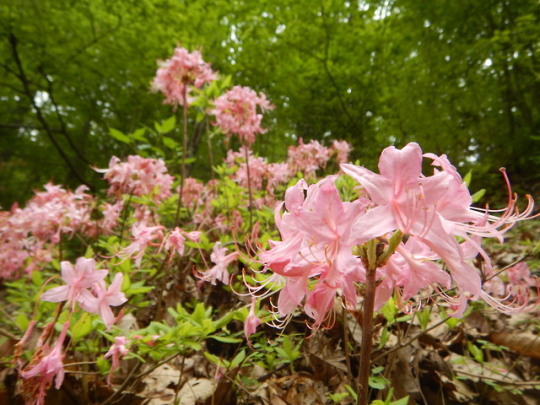
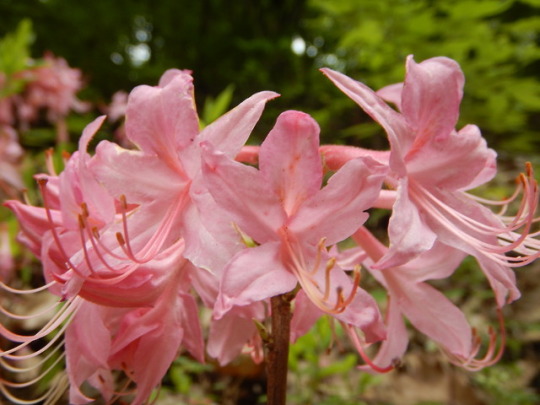
The Pinxter or Mountain Pink Azalea,
Rhododendron periclymenoides, is another classic species that is hard to pass up. The species follows many of the same trends that the Appalachian Flame Azalea is known for, from habitat to pollination. This species tends to have a much more closed off carolla tube than other species in my area and seems to garner more attention from the hummers than other species as well. We found this individual on a fairly steep road cut near the top of one of Ohio’s foot hills growing alongside an incredible seep based plant community. Interrupted ferns, whorled pogonia, shiney firm moss, Northern Maidenhair fern, and cinnamon fern, where just some species present in close proximity. Although it follows a highland trend overall, as long as the acidity is present and its protected from browsing it won’t be as fickle about where it lives.
16 notes
·
View notes
Photo

“Every flower must grow through dirt.”– Laurie Jean Sennott.- Taurus flowers: Aromatic, beautiful in bouquets, mostly pink, or those found growing wild in the fields. *Pinxter: Elegance, wealth, abundance. Taking care of yourself and other people around you. Temperance is a personality that is modest and kind to everyone, without any false representation. Being homesick. If you ever wondered which flower expresses this kind of feeling, this is the answer. * Apple blossom: Long life, magic, youth, beauty, and happiness. The apple has long been associated with the symbolism of immortality. Pink Aster: Patience, elegance, and delicacy. These flowers are very much associated with magic, as they are considered to be enchanted flowers. patience, elegance, and delicacy. *Sakura: A time of renewal and optimism, love, and the female mystique of strength, sexuality, and beauty. * Pink peonies: Love at first sight, the beauty of marriage, honor, happiness wealth, romance, and beauty. *Daisy: Childhood innocence, simplicity, and joy. *Pink Gerbera: Grace and fertility. Light pink expresses admiration and sympathy, dark pink ones are a symbol of gratitude. *White lilacs: Purity and innocence, The Celtics regarded the lilac as “magical” due to their incredibly intoxicating fragrance. #taurus #tauro #flor #flower #flowers #flores #astrologia #astrology #nature #naturaleza #signs #signos #art #arte #illustration #ilustracion #pintura #painting #artist #artista #tittigarelli #godessoflove #español #comment https://www.instagram.com/p/CazrzaSrLvr/?utm_medium=tumblr
#taurus#tauro#flor#flower#flowers#flores#astrologia#astrology#nature#naturaleza#signs#signos#art#arte#illustration#ilustracion#pintura#painting#artist#artista#tittigarelli#godessoflove#español#comment
1 note
·
View note
Photo
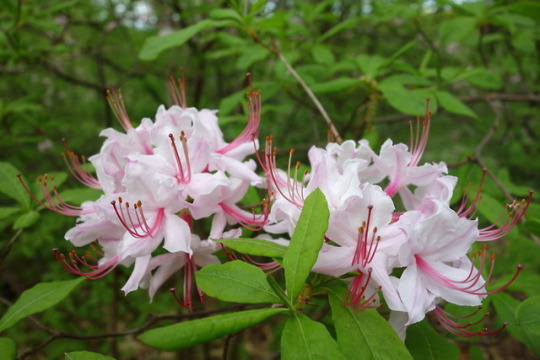
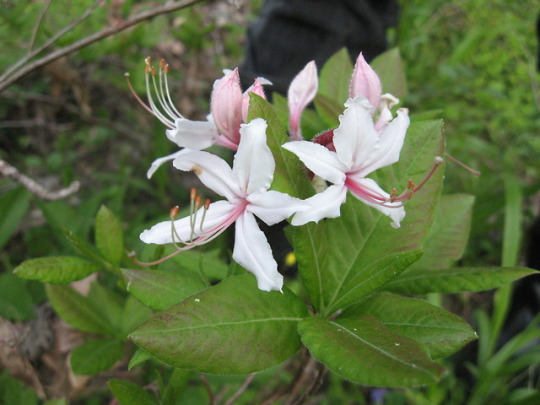
Pink azalea or pinxter flower (Rhododendron periclymenoides) is a species of shrub in the heath family. Like many members of the genus, the plant contains toxins in all parts of the flower.
33 notes
·
View notes
Text
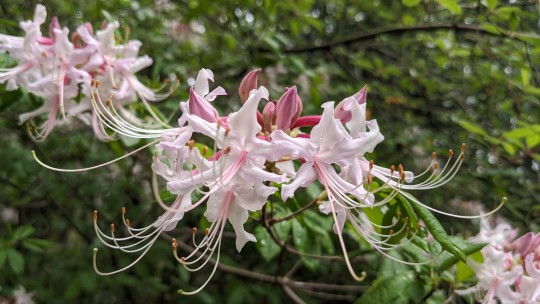
Rhododendron periclymenoides / Pinxter Flower at the Sarah P. Duke Gardens at Duke University in Durham, NC
#Rhododendron periclymenoides#Rhododendron#ericaceae#Pinxter Flower#Pink Azalea#Azalea#Azaleas#Native plants#Native flowers#Native shrubs#Plants#Flowers#Shrubs#Nature photography#photographers on tumblr#Sarah P. Duke Gardens#Duke Gardens#Duke University#Durham#Durham NC#North Carolina
2 notes
·
View notes
Photo

Wild Azalea, Pinxter Azalea, is native to the Piedmont region of the Southeast. Native Azaleas have especially showy flowers, that are a nectar source for butterflies and hummingbirds, according to https://vnps.org/. @jaypaulphoto #richmondmag #rva #nativeplants #spring #springblooms #walkinthewoods #parks #jamesriverparksystem (at James River Park) https://www.instagram.com/p/B-2CDyZlAh2I4VNmzwI6poCRzkgDQpQKd09rds0/?igshid=2213x1bq5tls
0 notes
Photo









Spring in the Chestnut Ridge brings out new treasures by the week. After finishing some chores this morning and letting the rain clear out of the area, I took a couple short hikes along Little Laurel and Glade Runs in Coppers Rock State Forest to sample the latest wave of treasures. Although the trails were both a squashy, muddy mess, I stopped sliding long enough to get a couple shots with the Cannon.
From top: The virgin hemlock forest along Little Laurel Run; pink lady slipper orchid; Canada mayflower; painted trillium; pinxter azalea; mayapple flower and leaves; a delicate fern growing from a moss-covered trunk, and a young shelf fungus emerging from a fallen hemlock.
57 notes
·
View notes
Text
What İs The Common Name For Rhododendron Periclymenoides?

Did you know that the scientific name of the Pinxterbloom Azalea, a deciduous shrub with pink flowers, is Rhododendron periclymenoides? The scientific name of the Pinxterbloom Azalea, Rhododendron periclymenoides, serves as a universal language for scientists studying this deciduous shrub. It distinguishes this species from others within the same genus and ensures clarity and precision in their study of its pink flowers and leaf description. Now let's dive into some fascinating facts about the native azalea, also known by its common name, Pinxter azalea. One interesting fact is it's bloom time.
Native Habitat and Distribution of Pinxterbloom Azalea
Native Habitat Distribution Eastern North America Eastern United States, from Maine to Florida and west to Mississippi Woodlands Moist acidic soils Wetlands Swamps, bogs, and stream banks Coastal Plains Sandy or peaty soils Mountains Upland forests and slopes Deciduous Forests Mixed hardwood forests Evergreen Forests Pine and oak forests The Pinxterbloom Azalea, or Rhododendron periclymenoides, is a common name for this vibrant flowering shrub in eastern North America. Its native habitat spans across the Chesapeake Bay and Tennessee regions, making it a popular collection for garden enthusiasts. This species thrives in various environments such as moist woodlands, swamps, and along stream banks. Here are some key points about the native habitat and distribution of Pinxterbloom Azalea: - Pinxterbloom Azalea's natural range extends from southern Canada to northern Florida. - The native azalea thrives in moist woodlands, benefiting from the shade provided by larger trees. Its bloom time is a sight to behold, especially for the Pinxter azalea. - The Pinxter azalea plant also demonstrates a remarkable ability to adapt to wetland areas like swamps. - Pinxterbloom Azaleas add a splash of color along stream banks with their beautiful blooms. The distribution of this azalea species showcases its versatility and resilience across various geographical locations. From the cooler climates of Canada to the warmer regions of Florida, these plants have adapted to thrive in different temperatures and growing conditions.
Common Names for Pinxterbloom Azalea
Common Names for Pinxterbloom Azalea Pinxterbloom Azalea Pink shell Azalea Pinxterflower Wild Honeysuckle Sweet Azalea Swamp Honeysuckle Hoary Azalea Roseshell Azalea Clammy Azalea Honeysuckle Azalea Pinxterbloom Azalea, apart from its scientific name, is also commonly referred to as Pinkster azalea or Swamp azalea. These common names are derived from the characteristics of this plant's pink flowers and its preference for swampy habitats. In addition to these widely recognized names, different regions may have their local names for this particular species. Common Names: - Pinkster azalea - Swamp azalea The common name "Pinkster azalea" highlights the vibrant pink color of the flowers that adorn this beautiful shrub. It serves as a vivid descriptor, capturing the eye-catching nature of its blossoms. Similarly, the name "Swamp azalea" emphasizes the preferred habitat of this species. Pinxterbloom Azaleas thrive in swampy areas where they can find ample moisture and shade. The name reflects their ability to adapt and flourish in such environments. It's worth noting that various regions might use additional local names for Pinxterbloom Azalea based on their unique cultural backgrounds or local traditions.
Relevance of Pinxterbloom Azalea to the Chesapeake Bay and Tennessee regions

The presence of Pinxterbloom Azaleas in the Chesapeake Bay and Tennessee regions is a clear indication of healthy ecosystems. These vibrant flowers not only add beauty to the landscape but also play a vital role in maintaining biodiversity. Pinxterbloom Azaleas provide food and shelter for various wildlife species, making them an essential part of the eastern United States' ecosystem. Birds, insects, and small mammals rely on these azaleas for nectar, pollen, and nesting sites. The abundance of these plants ensures a diverse range of habitats that support thriving populations. Conservation efforts are focused on preserving the habitat of the Pinxterbloom Azalea due to its ecological significance. By protecting these areas, we can safeguard the delicate balance that exists within our natural surroundings. This includes ensuring there are enough suitable conditions for the growth and reproduction of these azaleas.
Benefits of Pinxterbloom Azalea in Ecosystems

Pinxterbloom Azaleas offer numerous benefits to ecosystems, making them an essential component of the natural world. Let's explore how these vibrant flowers contribute to the environment: - Attracting Pollinators: The vibrant flowers of Pinxterbloom Azaleas act as a magnet for various pollinators, including bees, butterflies, and hummingbirds. These creatures are drawn to the nectar-rich blooms, aiding in the crucial process of pollination. - Soil Stabilization: With their extensive root systems, Pinxterbloom Azaleas play a vital role in preventing erosion along water bodies. Their roots firmly anchor the soil, reducing the risk of sediment runoff and maintaining stability. - Supporting Wildlife Populations: As native plant species, Pinxterbloom Azaleas provide valuable resources for indigenous wildlife. The nectar-rich flowers serve as a vital food source for many insects and animals. These plants create sheltered areas that offer protection and nesting opportunities. By attracting pollinators, contributing to soil stabilization, and supporting wildlife populations with their nectar-filled blossoms and protective habitats, Pinxterbloom Azaleas prove themselves as invaluable contributors to ecosystems.
Rhododendron Periclymenoides (Pinxterbloom Azalea) and its Variations
Variation Description 1 Pink flowers with dark pink stripes 2 White flowers with pink edges 3 Light pink flowers with yellow centers 4 Dark pink flowers with purple spots 5 Pale pink flowers with white centers The Rhododendron periclymenoides, commonly known as Pinxterbloom Azalea, is a deciduous shrub that belongs to the genus Rhododendron. This species exhibits fascinating variations of flower color, ranging from delicate pale pink to vibrant deep rose hues. These natural variations contribute to the overall diversity of the species and add visual interest to shrub borders and woodland areas. One intriguing aspect of Pinxterbloom Azalea's variations is the difference in fragrance among different cultivars. Some variations have a more pronounced fragrance compared to others, enhancing their appeal in gardens and landscapes. The sweet scent invites pollinators like bees and butterflies, making it a delightful addition to any outdoor space. When growing Rhododendron periclymenoides, it's important to be aware of potential issues that can affect its health. Like other azaleas and rhododendrons, this species may be susceptible to common pests such as aphids and diseases like powdery mildew or leaf spot. Regularly inspecting foliage can help identify any problems early on for prompt treatment. To ensure optimal growth, provide well-drained soil with sufficient moisture for this shrub's root system. Avoid overwatering as it can lead to root rot. Proper pruning techniques can also help maintain its shape and prevent the development of borers or other damaging insects. Pinxterbloom Azalea serves not only as an attractive hedge but also contributes to the ecological balance by providing a habitat for birds and insects. It's stunning flowers and lush green leaves make it a sought-after choice for both home gardeners and professional landscapers looking to create captivating outdoor spaces.
Appreciating the Beauty and Importance of Pinxterbloom Azalea

Pinxterbloom Azalea, scientifically known as Rhododendron periclymenoides, is a stunning flowering plant that holds great significance in various aspects. This native species can be found in the eastern regions of North America, particularly in the Chesapeake Bay and Tennessee areas. The beauty of Pinxterbloom Azalea lies not only in its vibrant flowers but also in its contribution to ecosystems. As a part of the Rhododendron family, it plays a crucial role in supporting biodiversity and maintaining the balance of natural habitats. Its presence provides food and shelter for numerous animal species, including birds, bees, and butterflies. This captivating plant is commonly referred to by different names such as Pinxter Flower, Wild Honeysuckle, and Swamp Pink. These names reflect its popularity among nature enthusiasts who appreciate its unique characteristics and ecological importance. If you are interested in exploring variations within the Rhododendron periclymenoides species, you will discover an array of fascinating traits and adaptations. From differences in flower color to variations in growth patterns, each variation adds to the allure of this remarkable plant. In conclusion, appreciating the beauty and importance of Pinxterbloom Azalea goes beyond admiring its visual appeal. By understanding its native habitat, common names, relevance to specific regions like the Chesapeake Bay and Tennessee, benefits within ecosystems, and variations within its species, we can truly grasp the value it brings to our environment. Take a moment to observe these magnificent blooms around you - they serve as a reminder of nature's intricate web of life. Consider incorporating Pinxterbloom Azaleas into your garden or supporting conservation efforts that protect their habitats. Together we can ensure that these enchanting plants continue to thrive for generations to come. Frequently Asked Questions Can Pinxterbloom Azalea be grown in containers? Yes, Pinxterbloom Azaleas can be grown in containers. However, it is crucial to provide adequate drainage and use a suitable potting mix to ensure the plant's health and growth. How often should I water Pinxterbloom Azalea? Pinxterbloom Azaleas prefer moist soil but not overly saturated conditions. Watering once or twice a week, depending on rainfall and temperature, is generally sufficient. It is important to monitor the moisture levels and adjust watering accordingly. Are Pinxterbloom Azaleas deer-resistant? While no plant can be considered completely deer-proof, Pinxterbloom Azaleas are known to have some level of resistance to deer browsing. However, hungry deer may still nibble on the leaves or flowers if other food sources are scarce. When is the best time to prune Pinxterbloom Azalea? The ideal time to prune Pinxterbloom Azalea is immediately after flowering. This allows the plant to set buds for the following year without disruption. Avoid pruning too late in the season as it may impact next year's bloom. Are there any specific care requirements for Pinxterbloom Azalea in colder climates? Pinxterbloom Azaleas are hardy plants that can tolerate colder climates. However, providing mulch around the base of the plant during winter months can help protect its roots from extremely cold temperatures. Do Pinxterbloom Azaleas attract pollinators? Yes, Pinxterbloom Azaleas are highly attractive to pollinators such as bees and butterflies. Read the full article
0 notes
Photo

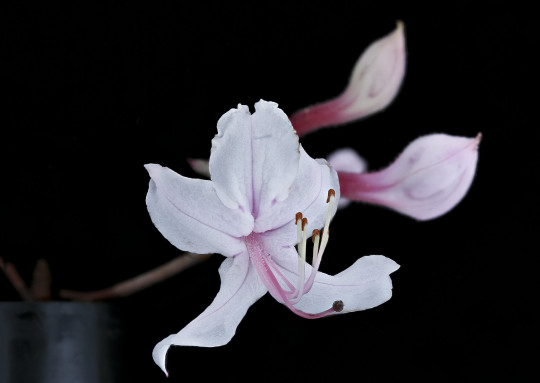
Here is one of the native azaleas...with the lovely name Pinxter (Rhododendron periclymenoides).
Note that most of the planted azaleas these days are not native and while they may or may not attract a few bumble bees and other species they are not nearly as excellent a species of plant to use as the Pinxter which has its own specialist bee, Andrena cornelli and is integrated into the surrounding natural world supporting many other insects and life forms that non-native azaleas do not, so, your choice, save the bees or not. Picture and specimen by Helen Lowe Metzman.
42 notes
·
View notes
